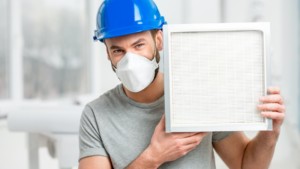
Change the Filters
Filters remove contaminants from the air, such as dust, pollen, hair, dander, mold, and spores. However, unless they’re changed regularly, these particles will clog the filter and restrict air circulation in your home. Most manufacturers recommend changing your air filters at least every three months, more often if you live in a particularly dusty climate.
Filters come in different sizes. Some are disposable. Some are reusable. Reusable filters generally have a plastic frame, while disposable ones have a cardboard one. Make sure you have the right size before you proceed. If the size isn’t marked, measure the length, width, and depth of the filter in order to determine the appropriate replacement.
Disposable filters can obviously be thrown out, but reusable filters should be brushed and then sprayed down with a hose. You can reinsert them immediately once they’re clean. Once you turn the air conditioner on, the filters will dry automatically. Keep in mind that depending on the size of your house, you may have to clean or replace more than one filter.
Filters come with arrows that tell you which direction they have to be installed to ensure proper airflow. For the most part, the arrow should be facing the unit. Installing the unit backward drives up your energy costs as the unit has to work harder to force air through.
Clean the Condenser Coils
Condenser coils contain coolant, which the coils convert from a gas to a liquid as it passes through. In the process, the coolant releases heat absorbed from inside your home. Condenser coils are housed in the condenser unit, typically located outside your house. In an effort to dissipate the heat, the unit runs air constantly over the coils, which draws in a lot of debris.
Like your air filters, if they aren’t cleaned, the coils will eventually become clogged and drive up your energy bills. First, shut off the power. Cleaning a fully powered unit is not only dangerous, but it could also cause serious damage. Next, clear away any leaves, twigs, or dirt on the outside covers.
Then remove the covers and scrub the coils with a soft brush. They are delicate, so be careful. Finally, hose the coils down. Use coil cleaner to get them extra clean. It can be purchased at any major hardware store. Clean both the inside and outside of the unit, starting at the top and working your way down to push the dirt through.
Clean the Drain
As air flows over the condenser coils, it cools down and leaves behind some condensation. If condensation is allowed to build up, eventually it can lead to mold, rust, and other problems. Fortunately, to solve this problem, every air conditioner includes a drain to remove moisture.
However, the drain can become clogged if not cleaned routinely. If you notice any standing water in the pan beneath the unit, it’s a sign the drain’s blocked. However, a simple wet/dry vacuum will clear it out in a few seconds. Once the pan is empty, take a moment to scrub it down with soap and water, to prevent mold from developing.
Remove Debris Around the Unit
Clearing the area around the condenser minimizes the number of stray particles that get sucked inside. This includes mowing the grass and removing any plants that may be growing on or near your air conditioner. Ideally, you should have roughly 12 inches of clear space around the unit.
Check the Condenser Level
Condensers are installed on large, concrete slabs outside your home. Though they’re generally stable, these slabs can become unsettled over time from erosion and soil compression. When this happens, it causes coolant to pool inside your air conditioner. Unless it’s taken care of, the trapped coolant can cause a breakdown requiring either serious repairs or a replacement unit.
Resettling the concrete isn’t cheap, but it’s much less expensive than purchasing a new condenser. The sooner you catch it, the less costly it’s likely to be. A simple level will tell you instantly whether there’s a problem. Simply place it on the slab and check the bubble. If it’s between the guidelines, your slab is fine.